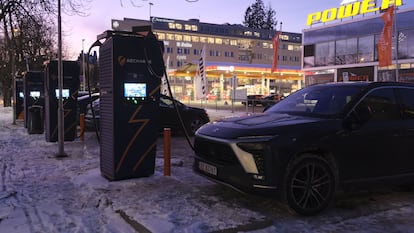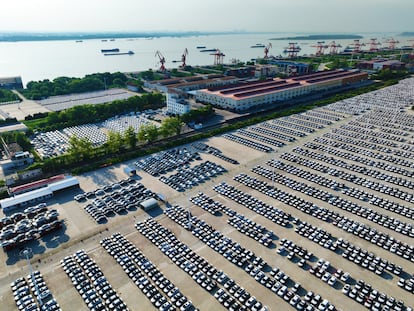Why 90% of cars sold in Norway are electric: VAT exemptions, free tolls and taxes on combustion vehicles
The Nordic country abolished taxes on zero-emission models in 2001, making them automatically cheaper than those powered by petrol or diesel

Norway, Europe’s largest oil exporter, has become the undisputed world leader in the electrification of road transportation: almost 90% of cars sold there last year were electric. The Scandinavian nation is now the only one in the world where there are more battery-powered vehicles on the road than petrol-powered ones. Despite its cold climate and low population density, Norway’s shift to electric cars began in the 1990s and was further accelerated by technological advancements, leading to exponential growth in zero-emission vehicles in recent years.
Christina Bu is one of the figures who has led the push for electric cars in Norway. Since 2014, she has served as the general secretary of the Norwegian Electric Vehicle Association (Norsk elbilforening). In a recent phone interview, Bu explains that Norway’s transformation would not have been possible without public incentives. The country has been promoting policies to favor electric vehicles over combustion cars for more than three decades. In 1990, it eliminated the road tax for electric vehicles; in 1996, it granted them free access to toll roads; and in 1999, it introduced free parking in certain cities. While some of these measures are no longer in place, they were crucial in making the purchase of electric vehicles an attractive option.
In 2001, Norway abolished VAT on electric cars, which automatically reduced their price compared to petrol or diesel vehicles. This is significant because in Norway, VAT adds a 25% premium to the cost of a conventional car. For example, a utility vehicle priced at €40,000 ($41,200) would cost €50,000 ($51,500) if it were combustion-powered. “The disincentives have been just as important as the incentives,” Bu points out. “Buying a polluting vehicle in Norway is really expensive; the electric car is the cheapest option,” she adds.
In some ways, Norway’s substantial revenues from oil and gas exports have made it easier for successive governments — all in agreement on this issue — to extend support for electric cars longer than in most European countries. Norway’s sovereign wealth fund, the largest in the world, is valued at €1.5 trillion ($1.55 trillion), a figure slightly higher than Spain’s GDP.
At first glance, Norway did not seem like a country suited to becoming a global leader in clean mobility. With its small population — just five million people in an area larger than Germany — its cold climate, and its mountainous terrain, the country faced clear obstacles to promoting green cars. The early stages of the road transport transformation were slow and unpromising. During the first few decades, incentives and public aid were not enough: the limited availability of electric models, their restricted range, and the scarcity of charging stations made the transition challenging. In 2012, electric cars accounted for just 3% of all new car purchases. By last year, that figure had soared to 89%, with some months reaching 94%.
Technological advances over recent decades have been crucial to this shift. Today, more than 160 models of electric vehicles are available in Norway, compared to fewer than 10 in 2014. Tesla has surpassed Toyota and Volkswagen to become the best-selling brand in the country, and cars manufactured in China are increasingly populating Norwegian cities. Along with a wider variety of models, improvements in vehicle range and the expansion of a robust charging infrastructure have been key factors driving the surge in electric vehicle adoption in recent years.
The Nordic country has 30,000 public charging points, making it home to the second-largest network in Europe relative to its population, behind only the Netherlands, which has a very high population density. For comparison, Spain has a similar number of chargers but for nearly 10 times the population (48 million), which puts off many potential buyers.
In 2017, the Norwegian parliament established 2025 as the target year for all new vehicle purchases to be zero-emission. Mikkel Friis, head of communications at the Norwegian Road Federation, explains in an email exchange that the 100% target is unlikely to be met this year. However, he believes that green car purchases could exceed 95% of the total. Friis also argues that “modern electric vehicles are much more resilient to winter conditions than those of a few years ago,” a factor that has contributed to the shift in the country’s more remote areas.
Unlike in the European Union, where sales of petrol and diesel cars will be banned starting in 2035, in Norway, there was no need for such a ban. “Gradually and progressively, the combustion engine car has been cornered and virtually driven off the market,” Bu explains.
Since last September, there have been more electric vehicles (28%) than petrol vehicles on the roads in Norway. However, diesel vehicles remain the most common, although most were purchased between 2005 and 2010, and the number of registrations has been steadily declining for years. Bu believes there is still a long way to go before the complete electrification of road transport, noting that electric vehicles and light commercial vehicles together account for less than 30% of the market.
The Nordic countries lead the way in electrification
Electric cars have not only found success in Norway but also throughout Northern Europe. In Iceland, sales of electric vehicles accounted for 71% of the total in 2023, followed by Sweden (60%), Finland (54%), and Denmark (46%), according to data from the International Energy Agency. The five Nordic countries lead the world in the adoption of green cars.
By comparison, in Spain, the zero-emission sales rate in 2024 was just 5.8% of the total (58,675 out of 1,015,654 units sold). One of the main barriers is the difficulty in accessing direct subsidies, unlike in the Nordic countries. Although subsidies are available — up to €7,000 ($7,200) for those scrapping their old car — the process to access them is cumbersome and can take up to two years. The entire sector is advocating for automatic discounts to help improve electric vehicle sales.
Portugal, despite having lower disposable income than Spain, offers a 100% VAT exemption for zero-emission vehicles and a discount on road tax. As a result, in 2023, Portugal tripled Spain’s sales of pure electric cars (18% compared to nearly 6%). In Spain, these incentives do not exist, though it is possible to deduct up to €3,000 ($3,100) (15% of the car’s purchase value) from personal income tax.
In countries where electric vehicle sales remain low, reluctance to adopt the technology persists — often fueled by misinformation and ignorance. However, once a critical mass is reached, the number of electric cars grows exponentially every year. As more people see friends, family, and acquaintances using these models, it becomes easier to convince them to try electric cars. This was the case in Norway, which reached 90% adoption in just over a decade, with exponential annual growth.
Sign up for our weekly newsletter to get more English-language news coverage from EL PAÍS USA Edition
Tu suscripción se está usando en otro dispositivo
¿Quieres añadir otro usuario a tu suscripción?
Si continúas leyendo en este dispositivo, no se podrá leer en el otro.
FlechaTu suscripción se está usando en otro dispositivo y solo puedes acceder a EL PAÍS desde un dispositivo a la vez.
Si quieres compartir tu cuenta, cambia tu suscripción a la modalidad Premium, así podrás añadir otro usuario. Cada uno accederá con su propia cuenta de email, lo que os permitirá personalizar vuestra experiencia en EL PAÍS.
¿Tienes una suscripción de empresa? Accede aquí para contratar más cuentas.
En el caso de no saber quién está usando tu cuenta, te recomendamos cambiar tu contraseña aquí.
Si decides continuar compartiendo tu cuenta, este mensaje se mostrará en tu dispositivo y en el de la otra persona que está usando tu cuenta de forma indefinida, afectando a tu experiencia de lectura. Puedes consultar aquí los términos y condiciones de la suscripción digital.
More information
Archived In
Últimas noticias
Innocence lost in the forest of the child soldiers: ‘Each leader of the armed group had his girls’
‘Fallout’ or how the world’s largest company turned an anti-capitalist apocalyptic Western into a phenomenon
From inflation to defending migrants: Eileen Higgins and Zohran Mamdani inaugurate the new Democratic resistance against Trump
EU’s prestige at stake with proposal to fund Ukrainian war effort with Russian assets
Most viewed
- ‘El Limones’ and the growing union disguise of Mexican organized crime
- Christian Louboutin: ‘Young people don’t want to be like their parents. And if their parents wear sneakers, they’re going to look for something else’
- The low-cost creative revolution: How technology is making art accessible to everyone
- ‘We are dying’: Cuba sinks into a health crisis amid medicine shortages and misdiagnosis
- A mountaineer, accused of manslaughter for the death of his partner during a climb: He silenced his phone and refused a helicopter rescue









































